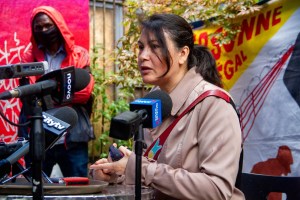You might be familiar with Patrick Swayze’s quote “Nobody puts Baby in a corner” from the movie “Dirty Dancing.” Yet as much as the movie has become a cult fascination, there is still an undervalued recognition for the artform that not only delivered its more emblematic scene but holds a valuable element for the understanding of today’s society. I am talking about dance and its mind-body connection.
Dance and Cultural Identity
There are lots of reasons why dance remains unfounded and undervalued, some of those reasons have to do with its power to shape growth in organisms, communities, societies, and history itself. Today’s societies are composed of individuals with various historical, social, and, geographical backgrounds. Globalization has brought to light the progress on human rights and migration regimes which now demand the reconstruction of the concept of identity to which we as individuals and societies cling to.
Octavio Paz, Nobel prize winner, and husband to the extremely talented Elena Garro, makes references in his writings to the body and dance as key elements of an honorable society and an elemental part of the construction of cultural identity. Many other writers, historians, and philosophers including Nietzsche, also make this association between dance, its qualities, and its positive influence on society. One example of this is Paz’s piece on “Conjunctions and Disjunctions” where he states: “Our era is critical, it has destroyed the old image of the world and has yet not created another one. That is why we do not have a body.” ( Paz, O., and H. R. Lane, 2015, Conjunctions and disjunctions: New York, Arcade Publishing).
In the latter phrase, Octavio Paz acknowledges a rupture between our intellectual advancement and our physical embodiment in the understanding of humanity. Practices such as body language, physical demeanor, movement patterns, and rhythm in tone are still being neglected in the academic fields that search for new tools to decode what identity means.
Reconnecting The Body to The Concept of Self
As academia searches for a deeper understanding of identity, dance offers a way of reconnecting the body to the concept of the self. For example, during the 1994 Amsterdam forum talks “The connected body?” intellectuals from different fields with interest in movement practices got together to discuss society’s disconnection between the body, the self, and how it relates in today’s world (Ric Allsopp & Scott deLahunta, “The Connected body?”, 1989: Amsterdam, School of the Arts). The goal of these talks was to spark a conversation about post-colonial views of identity in issues like reconciliation policies, woman studies, social rights struggles, and alternative approaches that could complement the understanding of these views.
To demonstrate this disconnection between the body and how it relates to today’s world, we can look at today’s current events with COVID-19, where some valuable insights into the understanding of human minds and behaviours come from non-traditional disciplines such as dance. To better illustrate this, we can use the social-media dance-app “Tik-Tok” as a case study. Its popularity exploded right after the disruption of societal routines and patterns that occurred due to the COVID-19 pandemic. This allowed us to witness how humans felt disconnected from their identity due to an aggressive disruption in their movement patterns, and how through dance they may reconcile their individual sense of belonging with the role they previously had in society. This reconnection with one’s identity through the body transcended geographical, generational, and ethnic barriers. With the Tik-Tok case, we can propose that identity is not associated with the roles of the individual, but it is rather a lived experience that creates connections between the individual and their environment as it is being experienced. Dance can enrich the sense of belonging in the now and welcomes multiple narratives within a story.
But while it is hard to name all the branches of dance, the peculiarity of these movement-based practices is the non-conventional approach to identity. The cognitive relation between sensation and the mind through movement, allows the body to document in real-time the experiences between the self and its environment, opening a door for new perspectives in the variations of human behaviour. This can be seen in contemporary dance practitioners who do not represent or play “a role,” but practice the experience of being, understanding, and existing while the body reacts to situations or concepts. With this approach, world events can be re-experienced and understood in works of choreographers that touch upon themes of slavery, migration, historical conflicts, or more conceptual subjects like gender and identity.
This is probably why dance has played an important role in identity and why its practice holds the tools to expose the raw, vulnerable conditions of human beings since the caveman periods, where tribes communicated and were recognized by movement patterns. Showing that the cognitive approach to self experiencing its environment continues to be the key element of several movement practices such as somatic work, contact improvisation, Butoh, and more.
The Legitimization of Dance
But the legitimization of these practices in the scientific and academic fields has not been easy. During the 16th century in France, dances were taken out of their context and their cultural significance became somewhat irrelevant for historians. During the reign of Louis XIV, dance as an identity constructor was used to exercise power over minorities based on gender, provenance, economical status, or ethnicity. Women were forbidden to participate in performances and considered less than men. Today, in governmental budgets given to culture, dance is allocated the lowest percentage. Even within the fine arts, dance has the lowest status due to misconceptions about the level of education of dancers. This example of segregation and the lack of historic documentation of both minorities and dance is what historians, like Arnold Toynbees and Dirk Hoerder, have been working on rectifying and broadening our understanding of humanity.
Some of the participants of the 1994 “The connected body?” forum researched the connection between body intelligence and the democratization of practices concerning the body by bringing together different approaches presented through experiments, performances, dissertations, panels, and other discursive means. The intention was to break down the authenticity of identity through movement. The discussions and findings from participants such as Marina Abramović and Scott deLahunta brought up the symbolic aspects of dance and its role in the identification and differentiation of individuals. This allowed them to present dance as a practice of movement as well as an expression of cultural practices… The contribution that research like this could bring to academia would allow a cohesion between dance and sociological studies, offering a path to a deeper understanding of human movement and the organization of society and its structures. One example of dance contributions to the academic field is the study of India’s Bharata Natyam, a style of dance that has survived over 12 centuries of social and political revolutions, and allows us to understand the impact of dance as a preservation of cultural identity. Bharata Natyam despite the sociopolitical climate throughout the years is still being practiced today. These types of cases, where dances successfully resist political and cultural changes, were studied in the 1994 “The connected body?” forum.
Dance as a Weapon Against Identity
In other cases, this quest of understanding one’s identity through dance has also contributed to strategies of repression. It has been used to rupture traditional lineages in countries like Afghanistan, where historians claim that dance was fundamental to the Pashtun tribe since 2000BC, and was considered a pillar of health and therapeutic practice. This dance is now forbidden and punished by death. Taliban insurgents have perverted the meaning of dance in Afghanistan as a military tactic. In the 1970s with the Iranian revolution; the law disallowed women from dancing in public. These examples show how dance, once a positive aspect of a society and an elemental anchor of Afghan identity, is used today as a weapon against identity.
These types of violations of the universal language of gesture have been used as effective strategies for repressive events in history such as colonization, Christianization, forbidding native dances, perverting societies, identities, and more. Similar to Afghanistan’s restriction on traditional dances, one can relate ceremonial dances in Africa where the holistic sense of dance was displaced by the imposition of the western patriarchy, sexualizing ceremonial dances that had, as the main objective, to worship and glorify a woman’s uterus. This led to the prioritization of the written word as the main means for documenting history and leaving movement practices as an invisible component of history. Without the recognition of dance as part of identity construction and as a tool to understand history, we neglect an important aspect of the development of the individual. “When humans don’t learn how to move their bodily selves,” as Nietzsche points out “their senses grow dull and they lose the capacity to discern what is good for them,” suggesting a deeper understanding of emotions when individuals are able to assess and see them reflected in their movement. The capacity that Nietzcshe was talking about to discern what is good, has been at the center of movements that advocate for dance and fight against repression of society. For example in Germany, a group called the Pirate Party started the combat against the legislation that prohibits dance demonstrations during Easter and in countries like Japan, dance as a political statement has been involved in acts of intense legislation and murder.
Tim Cresswell touches on the advocacy for dance in political and social movements with his studies of North American and Latin American dances (e.g. shimmie, tango) and the paradox of their reputation and their popularity within the British dance halls during the 20th century. These dances were seen as inappropriate, which scandalized the moral codes of British society. In public, you could hear these dances being labeled as degenerated and dirty moves, barbaric, eccentric, and dissolute, yet they were never absent inside dance parties and community events.
Further advancements for dance happened in North America during the twentieth century with the Judson Dance Theater congregations in New York in 1962 and the AUTOMATIST movement in Montreal, Canada in 1948. These two movements were the beginning of a historic process that changed the shape of dance in history.
The Democratisation of Dance
They were the first to bring people together from different academic, political, and artistic backgrounds for the study, experimentation, and documentation of movement practices. Prior to these two movements, there were also the achievements of Rudolf Laban (1879-1958), a Hungarian dance artist who researched and invented a number of tools for the analysis of movement and the relation of the body within itself and space. The approach Laban took towards movement sparked a consciousness amongst practitioners of the importance of movement in any human context: social, political, historical, and its importance in identity construction. Unfortunately, due to the major shifts of the political climate during WWII, his thorough research of movement, time, and effort didn’t have the expansion in academia that Laban was aiming for.
WWII migration’s regime interrupted Laban’s progress but some of his students and ideas spread around the globe. Laban’s predecessors continued practicing dance and working towards its democratization. Now, with a thriving need to reconcile their identities in this new land and era of a post-war fragmented society. Scholars such as Rudolf Laban, Isadora Duncan, Doris Humpfrey, and later on Steve Paxton, Merce Cunningham, and John Cage amongst others were interested in breaking these misconceptions in dance. They started to theorize and document dance by analyzing it in a way that validated their practices and schools. This allowed them to be translated to an academic language with the hope to credit dance as a formal study, thus these scholars were taking steps to introduce dance into the academic world.
Later on, the choreographers of the Judson Dance Theatre appeared. They were radical in their approach to dance, questioning and rejecting its aesthetic, formats, and previous codifications of dance movements like ballet and modern dance. In performances, experiments and weekly discussions they explored the ontological status of dance. These actions were groundbreaking in welcoming a new theory of dance as well as initiating political changes in the dance world by discovering a method of collaborative production with bases on identity construction. Rather than making new rules, they created on the premises of “anything goes,” allowing identity to assume its proposed definition of a fluctuating and conscious experience of being. It was what the post-war society needed in order to not lose their sense of the self, allowing them to process the sudden and drastic changes in the way the world functioned.
These advancements were groundbreaking, as it gave dance a place at the table regarding political issues. In the academic sphere, dance started to be introduced. Colleges, Universities, and even Masters programs were founded with a curriculum that advocated for dance as a “politically, socially, and spiritually transformative force in society.” These tools now given to dance through its documentation and new approach allowed dance, little by little, to have a platform in artistic and political movements that redefined gender, personal, and group identities, its political and religious status as well as its aesthetic values.
The space that dance began to occupy in social movements was particularly notable in Montreal. In the middle of the “revolution tranquille” (the quiet revolution), the inclusion of dance in the political scene gave it a stronger voice and allowed something revolutionary to happen as French-Canadians fought the ongoing suppressive power that the church had over them since 1759.
Françoise Riopelle and Françoise Sullivan, both dancers and choreographers, were amongst the redactors of the “Refus global,” a document written during the “revolution tranquille” that emancipated individuals from any oppression from the church and the state in regards to the state of the body, how to use it, and how to relate to it. This allowed French-Canadian society to adopt a new ideology regarding dance and movement practices. As a result of this, dance bloomed in the mid-80s in Montreal, now becoming one of the most influential Contemporary Dance centers in North America. This allowed it to have tangible contributions to culture and society at large, such as the TransAmerique Festival, the RQD research and development association for dance, and the Master programs in movement and cognition in universities like UQAM (Université de Québec à Montréal). And so, a new layer of dance started to be understood by western academia.
Dance Within Western Academia
More and more scholars and health practitioners are introducing several tools and techniques of bodily movement in their research on the evolution of the human species, and the psychological development of individuals. In Nietzsche’s critique of western European Christian morality (“On the Genealogy of Morals,” 1887), dance is presented as a divine practice incorporated in the habits of the strong in order to gain and cultivate the ability to digest their experiences, in Nietzsche’s words; “those who dance are not burdened by resentment, or need for revenge.” As Wendi Whelen, a former dancer for the New York City Ballet said “we are constantly revealing ourselves to each other through movement.”
The development of the sciences of the mind in the 21st century, where the study of human behaviour involves both the scientific study of the composition of a being (genetics, chemistry, biology) and its sensorial experiences such as thoughts and emotions has created a springboard for the recognition of dance practices in Western Academia. The innovative approaches that dance offers to the study of human behaviour and the tools it uses to present a much more dynamic meaning to identity construction like embodiment, enacted imagination, etc. allow a new range of angles in which scholars can understand the history and the complex acts of “quintessential” human behaviour that wrote it. These proposed techniques on the study of the body as a vehicle that holds the complexity of a dynamic identity challenge the “Western notions of human beings that privilege mind over body.”
In conclusion, movement shapes growth, whether it is of an organism, a community, a society, or history itself. The result of movement can be seen in an individual’s body language, physical demeanor, and more intricate characteristics of a human being such as its behaviour and identity. Another example of movement as a shaping force is the way society grows, evolution, migration, innovation, history, dance, and more… Understanding that through dance, the individual acquires a certain agency that allows them to consciously dissociate or associate elements in our surroundings as part of a dynamic identity, could expand the understanding of history and the human behavioral sciences of Western Academia.
Finally, adding movement practices as a means for understanding and documenting history, could offer a new perspective on the process of development of the individual. With a perspective of body and mind as one, academia could benefit from alternative insights into the human mind, the consciousness of the self, and its free will. As Nietzcshe proposed, we could gain a sensorial consciousness and a capacity to discern what is good for humanity.







